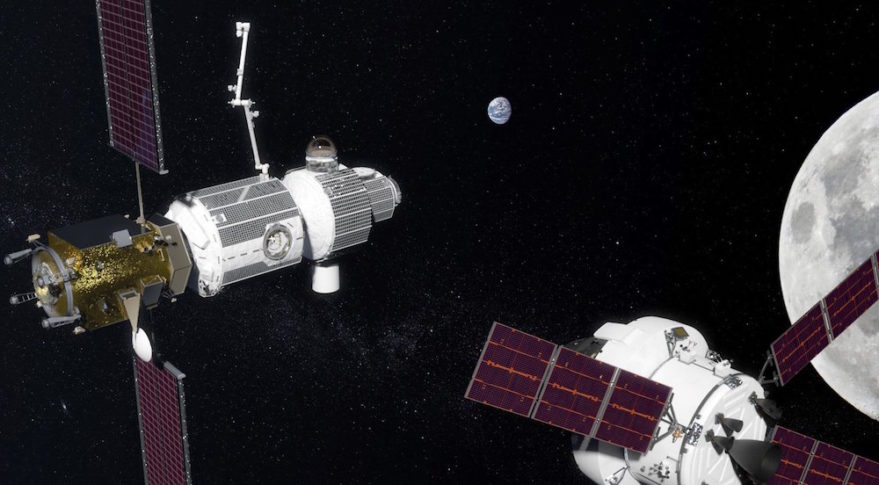European Space Officials Outline Desired Contribution to Deep Space Gateway

BREMEN, Germany – Europe's aerospace industry is getting ready for NASA's proposed Deep Space Gateway, hoping Europe will have its own module at the lunar-orbit space station resupplied by a European transportation system.
During a session on the final day of Space Tech Expo Europe in Bremen, Germany, Frederic Masson, an engineer at French space agency CNES, said France is already considering ways to increase performance of the upcoming Ariane 6 launcher to make it fit to contribute to humankind's next big space endeavor.
"We are preparing a demonstrator for a reusable first stage that is called Calisto," Masson said. "But we think the most efficient thing would be to add a solar electric space tug as an additional stage." [Mars Samples Could Reach Earth Via Deep Space Gateway]
Such a space tug concept, Masson said, is already being studied by Airbus Defence and Space.
"If we use an Ariane 6 and a 60 [kilowatt] space tug, we could bring up 9 tons of cargo to the Deep Space Gateway," Masson said during a presentation, adding the technology could be ready for use in 2024 or 2025.
Detlef Wilde, head of robotics projects at Airbus Defence and Space, said that ESA has been discussing the Deep Space Gateway concept with NASA for the past two years and although the venture is not yet approved, "the increasingly engaging discussions show that it has sense."
Wilde said that per the current plan, first phase of Deep Space Gateway's construction could be completed as early as 2026, with the first module being transported to the lunar orbit in 2022 as part of the first crewed mission of NASA's Orion spacecraft.
Get the Space.com Newsletter
Breaking space news, the latest updates on rocket launches, skywatching events and more!
Wilde said the first crewed launch of Orion and the Space Launch System heavy-lift rocket — dubbed Exploration Mission (EM)-2 "will also launch the propulsion element as the first element of the Deep Space Gateway."
"Then typically we would see one launch every year, the other elements of the Deep Space Gateway will be brought up," he said.
Airbus Defence and Space builds Orion's service module at its Bremen site. Comprising 50 percent of the spacecraft, the service module provides power and propulsion, as well as some life support functions.
While Orion SLS would be used to transport most of the heavy components, Ariane 6 and its space tugs would still be needed for additional logistics, Wilde said.
Airbus Defence and Space and its European partners expect to build a habitat and a logistics module, which would form the European segment of the Deep Space Gateway.
"The design of the modules is based on the heritage of the ISS," Wilde said. "We have much less space to live and work here though. On the ISS, each crew member has more then 100 cubic meters to live and work. Here in the habitat, we are talking about 20 to 25 cubic meters per person."
Electric propulsion technology, avionics, habitation technology and crew systems are additional areas the European space players hope to work on.
Masson said CNES is also working on a nuclear electric propulsion system that could be possibly used for a future mission to Mars. The project, called Democritos and funded through the EU's Horizon 2020 research program, is a joint project between several European and Russian research institutes.
The Deep Space Gateway is expected to serve as a basis for the exploration of moon and a launching point for mission to Mars and further destinations. The station will to be designed to support a human crew for about 40 days, according to John Roth, vice president of strategy and business Development at Sierra Nevada Corp., one of five companies hired by NASA to develop the Deep Space Gateway architecture.
Roth also said that reusing and building on existing technologies would be key to accomplish the Deep Space Gateway cost-effectively.
This story was provided by SpaceNews, dedicated to covering all aspects of the space industry.
Join our Space Forums to keep talking space on the latest missions, night sky and more! And if you have a news tip, correction or comment, let us know at: community@space.com.

Tereza is a London-based science and technology journalist, aspiring fiction writer and amateur gymnast. Originally from Prague, the Czech Republic, she spent the first seven years of her career working as a reporter, script-writer and presenter for various TV programmes of the Czech Public Service Television. She later took a career break to pursue further education and added a Master's in Science from the International Space University, France, to her Bachelor's in Journalism and Master's in Cultural Anthropology from Prague's Charles University. She worked as a reporter at the Engineering and Technology magazine, freelanced for a range of publications including Live Science, Space.com, Professional Engineering, Via Satellite and Space News and served as a maternity cover science editor at the European Space Agency.










